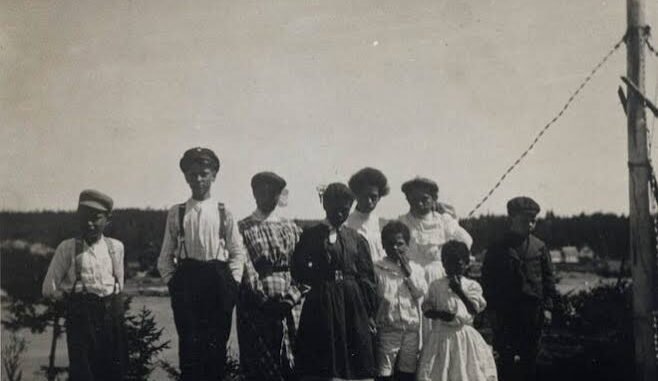
At an event at Malaga Island Preserve, people congregate to eat. To commemorate the Black and mixed-race islanders who were expelled from their colony in the early 1900s, cutouts were placed all over the island.
If it was a sunny day, perhaps a Sunday, Mainers with enough money to buy or rent a boat would cruise by Malaga Island for a peak at the curious inhabitants. It was the beginning of the 20th century, a time of unquestioned racial separation. But here on the little Casco Bay island was a true oddity: blacks, whites and mixed-race people lived together in a cooperative community. On an average day – according to information gleaned from photographs, excavations and oral tradition – children of every shade played together, men hand fished for cod and women sat with one another, chatting outside the clapboard houses. The gapers bobbing in the bay had almost certainly heard talk of stranger things: rumors of “mentally retarded” mixed-race inhabitants, whisperings that Malaga children had horns and burrowed in tunnels. It was said ashore in Phippsburg that islanders were immoral and savage, that they ate their food uncooked and bore the telltale signs of syphilis.
To this day, in the Casco Bay region, the term “Malagite” is considered a racial slur on a par with the n-word. Descendants of the islanders kept their history secret rather than be associated with both the ugly rumors and the ugly truths about Malaga, truths like the institutionalization of mixed race islanders – considered by the proponents of eugenics to be intellectually and morally defective – at the Maine School for the Feeble-Minded where they were classified as “imbeciles” or “morons.” Justin Marr, 46, has embraced his Malaga heritage, which he knew nothing about until he was 35. The Rockland, Maine, resident is open about his connection, even in Phippsburg, which is shouting distance from the now-uninhabited island. That doesn’t mean bigotry isn’t an issue, however. Not long ago, Marr was at a family gathering in the coastal town. Bob Marley music played over the speakers. A white man in attendance said aloud that he was glad to get a break from “black” music: “Bob Marley is black,” Marr says, recalling his comment to the man with a slight chuckle. The man shot back: “Oh, yeah, you’re one of ‘them’…” That sentiment still has a vice grip on pockets of the region. In the early 1900s, talk of the peculiar island saturated Maine’s coastal areas. Government officials became increasingly certain that something needed to be done. Gov. Frederick Plaisted visited Malaga in 1911. He had this to say to the Brunswick Times Record: “The best plan would be to burn down the shacks with all their filth. Certainly, the conditions are not creditable to our state, and we ought not to have such things near our front door.” The increased interest in Malaga, decades after the community was established, coincided with the decline of Maine’s wooden shipbuilding economy and the beginning of the state’s tourism industry. Islands, considered virtually worthless since the state’s founding in 1820, were suddenly being eyed by developers and the state officials as potential gold mines. In 1912, after 50 years eking out a living on Malaga, islanders were evicted by order of Gov. Plaisted. When state officials showed up on the evacuation deadline, residents were already gone. They had taken their houses with them. The only visible remains of the community were a schoolhouse and a cemetery. Descendants have heard tales that some of their family members made wooden rafts and floated south toward Portland with their deconstructed houses. This much is known: Four of six mixed-race residents died at the School for the Feeble-Minded. The two women survivors never produced any children.

Be the first to comment